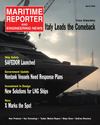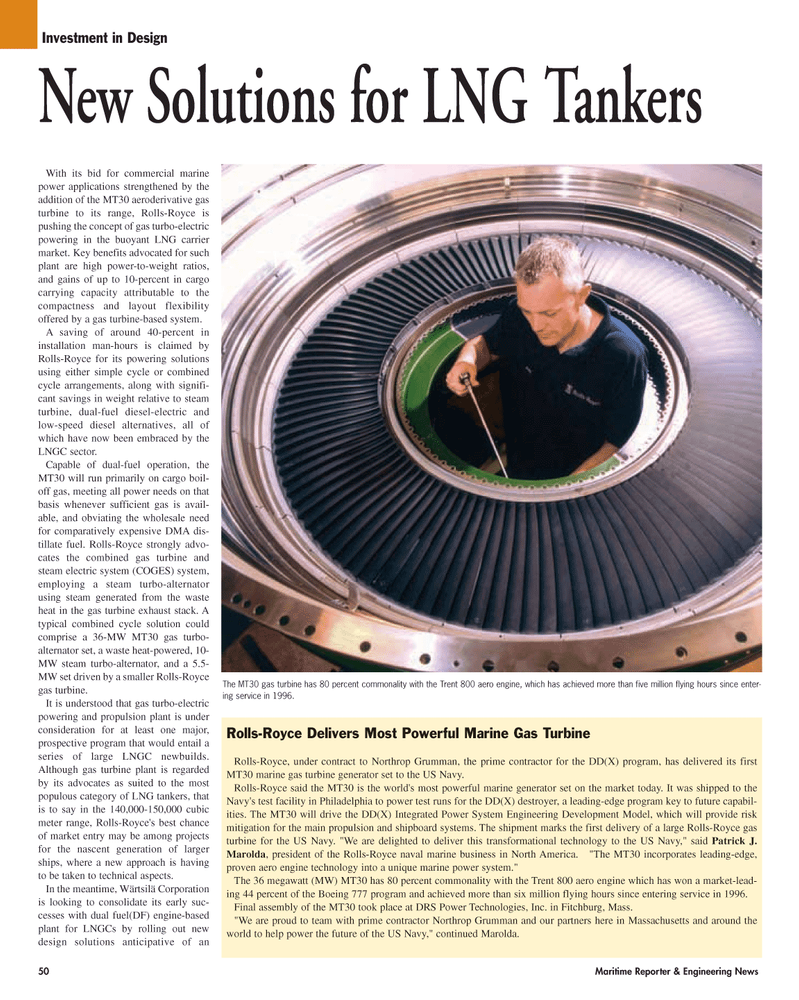
Page 50: of Maritime Reporter Magazine (March 2, 2005)
Read this page in Pdf, Flash or Html5 edition of March 2, 2005 Maritime Reporter Magazine
50 Maritime Reporter & Engineering News
With its bid for commercial marine power applications strengthened by the addition of the MT30 aeroderivative gas turbine to its range, Rolls-Royce is pushing the concept of gas turbo-electric powering in the buoyant LNG carrier market. Key benefits advocated for such plant are high power-to-weight ratios, and gains of up to 10-percent in cargo carrying capacity attributable to the compactness and layout flexibility offered by a gas turbine-based system.
A saving of around 40-percent in installation man-hours is claimed by
Rolls-Royce for its powering solutions using either simple cycle or combined cycle arrangements, along with signifi- cant savings in weight relative to steam turbine, dual-fuel diesel-electric and low-speed diesel alternatives, all of which have now been embraced by the
LNGC sector.
Capable of dual-fuel operation, the
MT30 will run primarily on cargo boil- off gas, meeting all power needs on that basis whenever sufficient gas is avail- able, and obviating the wholesale need for comparatively expensive DMA dis- tillate fuel. Rolls-Royce strongly advo- cates the combined gas turbine and steam electric system (COGES) system, employing a steam turbo-alternator using steam generated from the waste heat in the gas turbine exhaust stack. A typical combined cycle solution could comprise a 36-MW MT30 gas turbo- alternator set, a waste heat-powered, 10-
MW steam turbo-alternator, and a 5.5-
MW set driven by a smaller Rolls-Royce gas turbine.
It is understood that gas turbo-electric powering and propulsion plant is under consideration for at least one major, prospective program that would entail a series of large LNGC newbuilds.
Although gas turbine plant is regarded by its advocates as suited to the most populous category of LNG tankers, that is to say in the 140,000-150,000 cubic meter range, Rolls-Royce's best chance of market entry may be among projects for the nascent generation of larger ships, where a new approach is having to be taken to technical aspects.
In the meantime, Wärtsilä Corporation is looking to consolidate its early suc- cesses with dual fuel(DF) engine-based plant for LNGCs by rolling out new design solutions anticipative of an
Investment in Design
New Solutions for LNG Tankers
The MT30 gas turbine has 80 percent commonality with the Trent 800 aero engine, which has achieved more than five million flying hours since enter- ing service in 1996.
Rolls-Royce Delivers Most Powerful Marine Gas Turbine
Rolls-Royce, under contract to Northrop Grumman, the prime contractor for the DD(X) program, has delivered its first
MT30 marine gas turbine generator set to the US Navy.
Rolls-Royce said the MT30 is the world's most powerful marine generator set on the market today. It was shipped to the
Navy's test facility in Philadelphia to power test runs for the DD(X) destroyer, a leading-edge program key to future capabil- ities. The MT30 will drive the DD(X) Integrated Power System Engineering Development Model, which will provide risk mitigation for the main propulsion and shipboard systems. The shipment marks the first delivery of a large Rolls-Royce gas turbine for the US Navy. "We are delighted to deliver this transformational technology to the US Navy," said Patrick J.
Marolda, president of the Rolls-Royce naval marine business in North America. "The MT30 incorporates leading-edge, proven aero engine technology into a unique marine power system."
The 36 megawatt (MW) MT30 has 80 percent commonality with the Trent 800 aero engine which has won a market-lead- ing 44 percent of the Boeing 777 program and achieved more than six million flying hours since entering service in 1996.
Final assembly of the MT30 took place at DRS Power Technologies, Inc. in Fitchburg, Mass. "We are proud to team with prime contractor Northrop Grumman and our partners here in Massachusetts and around the world to help power the future of the US Navy," continued Marolda.
MR MARCH 2005 #7 (49-56).qxd 3/1/2005 4:53 PM Page 2

 49
49

 51
51
